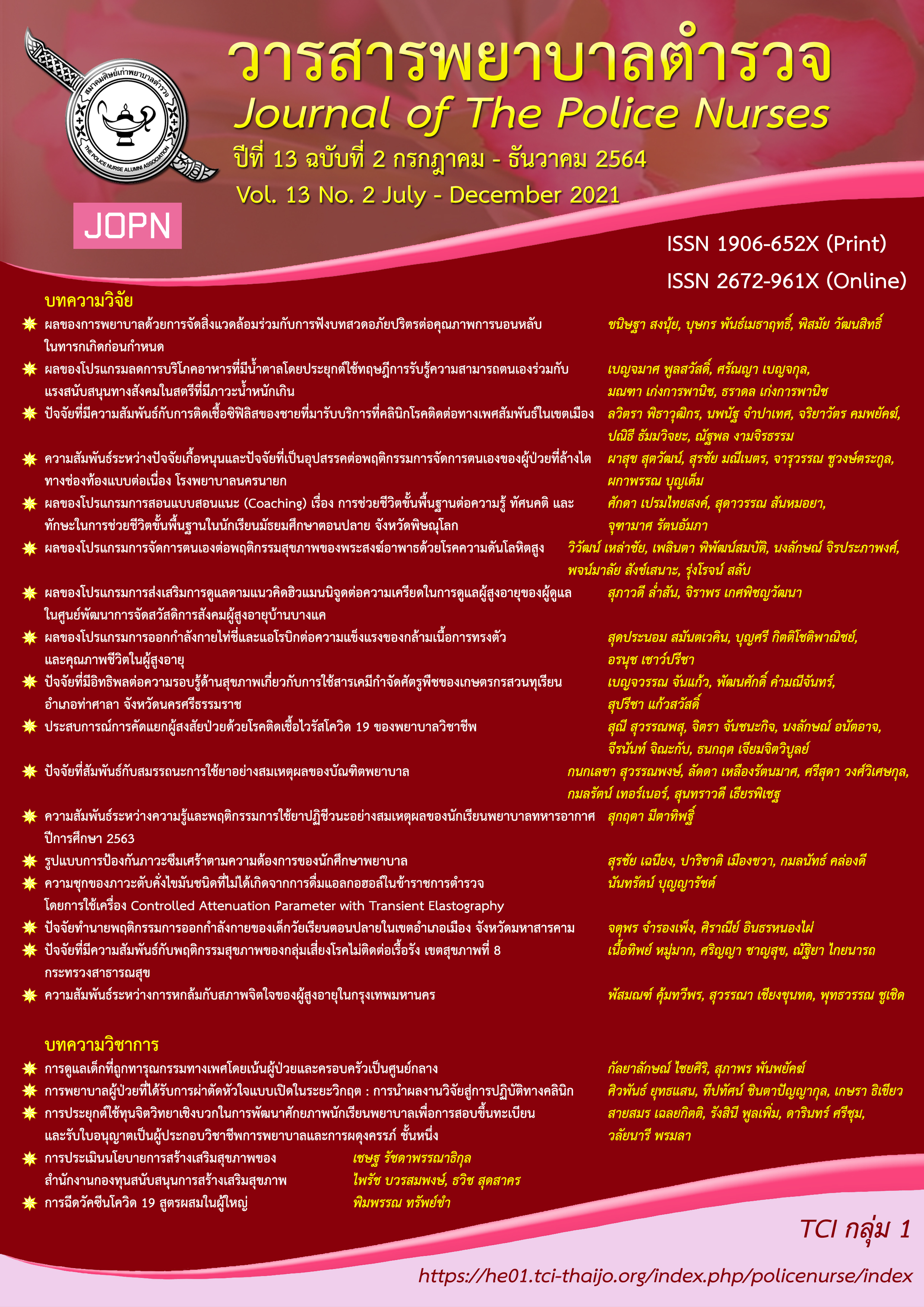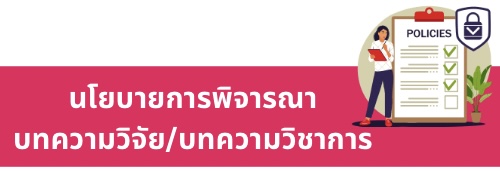ผลของโปรแกรมการออกกำลังกายไท่ชี่และแอโรบิกต่อความแข็งแรงของกล้ามเนื้อ การทรงตัวและคุณภาพชีวิตในผู้สูงอายุ
คำสำคัญ:
การออกกำลังกายไท่ชี่และแอโรบิค, การทรงตัว, คุณภาพชีวิต, ผู้สูงอายุ, ความแข็งแรงของกล้ามเนื้อบทคัดย่อ
การวิจัยนี้เป็นการวิจัยกึ่งทดลองเพื่อเปรียบเทียบผลของโปรแกรมการออกกำลังกายไท่ชี่และแอโรบิกต่อความแข็งแรงของกล้ามเนื้อขา การทรงตัวและคุณภาพชีวิตในผู้สูงอายุ ตัวอย่างวิจัยเป็นผู้สูงอายุ จำนวน 66 คน ที่มาเข้าโปรแกรมส่งเสริมสุขภาพ ณ โรงพยาบาลสิรินธร เขตประเวศ กรุงเทพมหานคร แบ่งเป็นกลุ่มทดลองและกลุ่มควบคุม อย่างละ 33 คน โดยกลุ่มทดลองมีการออกกำลังกายเสริมด้วยไท่ชี่เป็นเวลา 50 นาทีต่อวัน สัปดาห์ละ 3 วัน แบบวันเว้นวันเป็นเวลาต่อเนื่อง 8 สัปดาห์ แล้วทดสอบความแข็งแรงของกล้ามเนื้อหลัง-ขา และการทรงตัวด้วยระยะเวลาของการยืนขาเดียวและการวางเท้าต่อเท้า เครื่องมือดังกล่าวได้รับการทดสอบและผ่านเกณฑ์มาตรฐานสมรรถภาพของกรมพลศึกษา วิเคราะห์ข้อมูลเชิงปริมาณโดยใช้ค่าเฉลี่ย ส่วนเบี่ยงเบนมาตรฐาน การวิเคราะห์ความแตกต่างของความแข็งแรงของกล้ามเนื้อและการทรงตัว ใช้การทดสอบที (paired t-test and independent t-test) ข้อมูลจากการสัมภาษณ์ใช้การวิเคราะห์เนื้อหา
ผลการวิจัยพบว่า 1) ผู้สูงอายุกลุ่มทดลองมีความแข็งแรงของกล้ามเนื้อขาและการทรงตัวด้วยการยืนขาเดียวและการวางเท้าต่อเท้า เพิ่มขึ้นมากกว่ากลุ่มควบคุมอย่างมีนัยสำคัญทางสถิติที่ระดับ .05 และ 2) ผู้สูงอายุกลุ่มทดลองมีคุณภาพชีวิตด้านกาย จิต-อารมณ์ สังคมและสิ่งแวดล้อม ดีขึ้นกว่ากลุ่มควบคุม สรุปผลการวิจัยว่า โปรแกรมการออกกำลังกายไท่ชี่และแอโรบิกเป็นเวลาต่อเนื่องช่วยเสริมสร้างความแข็งแรงของกล้ามเนื้อและการทรงตัว ช่วยลดความเสี่ยงต่อการหกล้มและส่งเสริมคุณภาพชีวิตในผู้สูงอายุ
Downloads
เอกสารอ้างอิง
Chan, S. P., Luk, T. C., & Hong, Y. (2003). Kinematic and electromyographic analysis of the push movement in Tai Chi. British Journal of Sports Medicine, 37(4), 339-344.
Department of Physical Education, Ministry of Tourism and Sports.(2019). Physical fitness test and benchmark for people aged 60 - 69 years.
Department of Economics and Social Affairs: Population Division. (2015). World population agingreport. United Nation. New York.
Guo, Y., Shi, H., Yu, D., & Qiu, P. (2016). Health benefits of Traditional Chinese sports and Physical activity for Older adult: A Systematic review of evidence. Journal of Sport and Health Science, 5(3), 270–280.
Gyllensten, A. L., Hui-Chan, W. Y., & Tsang, W. N. (2010). Stability limits, single-leg jump, and body awareness in older Tai Chi practitioners. Archives of Physical Medicine and Rehabilitation, 91(2), 215-220.
Houry, D., Florence, C., Baidwin, G., Stevens, J., & Mcclure, R. (2016). The CDC injury centre’ s response to the growing public health problem of fall among older adults. American Journal of Lifestyle medicine, 10(1), 74-77.
Hu, Y. N., Jung, Y. J., Yu, H. K., Chen, Y. C., Tsai, C. T., & Hu, G. H. (2016). Effect of Tai Chi exercise on fall prevention in older adults: Systematic review and meta-analysis of randomized controlled trials. International Journal of Gerontology, 10(3), 131-136.
Huang, Y., & Liu, X. (2015). Improvement of balance control ability and flexibility in the elderly Tai Chi Chuan practitioners: A systematic review and meta-analysis. Archives of Gerontology and Geriatrics, 60(2), 233-238.
Jiménez-Martín, P. J., Meléndez-Ortega, A., Albers, U., & Schofield, D. (2013). A review of Tai Chi Chuan and parameters related to balance. European Journal of Integrative Medicine, 5(6), 469-475.
Ku, Y. C., Liu, M. E., Tsai, Y. E., Liu, W. C., Lin, W. L., & Tsai, S. J. (2013). Associated factors for falls, recurrent falls, and injurious falls in aged men living in Taiwan veterans homes. International Journal of Gerontoogy, 7(2), 80–84.
Lan, C., Lai, J. S., Chen, S. Y., & Lai, J. S., & Wong, A. M. (2013). Chi Chuan in medicine and health promotion. Complementary and Alternative Medicine (Review Article), Hindawi Publishing Corporation. Retrieved from https://www.hindawi.com
Leung, D. K., Chan, C. L., Tsang, W. N., & Tsang, A. J. (2011). Tai Chi as an intervention to improve balance and reduce falls in older adults: A systematic and meta-analytical review. Alternative Therapies in Health and Medicine, 17(1), 40-48.
Li, J. X., Xu, D. Q., & Hong, Y. L. (2009). Changes in muscle strength, endurance, and reaction of the lower extremitied with Tai Chi intervention. Journal of Biomechanics, 42, 967- 971.
Mahaprom, T., Monkong, S., & Wongvatunyu, S. (2017). Tai Chi practice and its impact on elderly people’s balance. Thai Journal of Nursing Council, 32(3) 50-65.
National StatisticalOffice. (2018). Report on the 2017 survey of the older persons in Thailand. Retrieved from http://www.nso.go.th
Rogers, C., Larkey, L. K., & Keller, C. A. (2009). Review of clinical trials of Tai Chi and Qigong in older adults. Western Journal of Nursing Researcs, 31(2),245 -279.
Sarapun, A., Sirisopon, N., Kainaka, P., Onsiri, S., Outayanik, B., Threrawachjareanchai, S., & Sukomol, N.(2017). Factors related to a fall prevention behaviors of elderly. Journal of The Royal Thai Army Nurses, 18(supplement), 215 –222.
Soogaroon, S., Palasuwan, A., Suksom, D., & Anugoolpracha, C. (2011). Effects of modified miracle Tai Chi training on health-related physical fitness in the elderly women. The report was part of the research project: Tai Chi training in elderly health promotion. Chulalongkorn University.
Tsang, W. W., & Hui-Chan, C. W. (2004). Effects of 4 - and 8 -wk intensive Tai Chi training on balance control in the elderly. Medicine & Science in Sports Exercis, 36(4), 648 -657.
United Nation. (2017). World population ageing 2017: Highlights–UN ilibrary. Retrieved from https://www.un-ilibrary.org
Wang, S. J., Xu, D. Q., & Li, J. X. (2017). Effect of regular Tai Chi practice and jogging on neuromuscular reaction during lateral postural control in older people. Research in Sports Medicine, 25(1), 111-117.
Wong, A. M. K., & Lan, C. (2008). Tai Chi and balance control. Medicine and Sport Science, 52, 115-123.
Xu, D. Q., Li, J. X., & Hong, Y. L. (2005). Effect of regular Tai Chi and jogging exercise on neuromuscular reaction in older people. Age and Aging, 34, 439 -444.
Xu, D. Q., Hong, Y.L., & Li, J. X., (2008). Tai Chi exercise and muscle strength and endurance in older people. Medicine and Sport Science, 52, 20-29.
ดาวน์โหลด
เผยแพร่แล้ว
รูปแบบการอ้างอิง
ฉบับ
ประเภทบทความ
สัญญาอนุญาต
ผลงานที่ได้ตีพิมพ์แล้วจะเป็นลิขสิทธิ์ของวารสารพยาบาลตำรวจ















